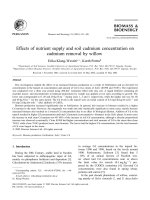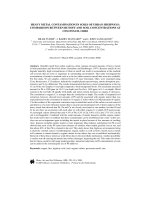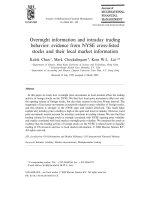Clays, clay minerals and soil shrinkswell behavior
Bạn đang xem bản rút gọn của tài liệu. Xem và tải ngay bản đầy đủ của tài liệu tại đây (5.45 MB, 32 trang )
Hillel, pp. 75-100
Clays, Clay Minerals and Soil
Shrink/Swell Behavior
CE/ENVE 320 – Vadose Zone Hydrology/Soil Physics
Spring 2004
Copyright © Markus Tuller and Dani Or 2002-2004
Introduction
• Volume and pore space of swelling clayey soils vary with
hydration state.
• Shrink-swell phenomena affect many mechanical and
engineering properties of soils and clay liners.
• Constitutive transport properties for swelling soils are
complicated by hydration-dependent soil attributes (pore
space, strength, etc).
Copyright© Markus Tuller and Dani Or2002-2004
Clay shrink/swell damage to structures & roads
Changes in soil water content or solution chemistry of
clayey soils induce swelling pressures sufficiently large
to fracture and damage structures and roads.
Estimated damage in excess of $7 billion/yr in the US.
Copyright© Markus Tuller and Dani Or2002-2004
Clay Minerals – building blocks
●
Distinguish between “clay” size <2µm and clay minerals
●
Basic building blocks of clay minerals:
●
Silica centered tetrahedra
●
Al3+ (+ other cations Mg2+ ) centered octahedra
Copyright© Markus Tuller and Dani Or2002-2004
Formation of Silica and Alumina Sheets
●
The tetrahedra are joined (share
oxygen) at their basal corners in a
hexagonal pattern forming flat sheets
~ 0.493 nm thick.
10 µm
●
The octahedra join along their edge to
form triangular array 0.505 nm thick.
●
Stacked sheets form lamellae.
Copyright© Markus Tuller and Dani Or2002-2004
Isomorphic substitution
●
The space occupied by silica in a tetrahedron can
accommodate atoms <~0.4 times O 2 radius (Si4+ & Al3+).
●
Octahedra - 0.732 times O2 radius (accommodates iron,
magnesium, aluminum, manganese, titanium, sodium, calcium)
●
Substitution of central atoms with valence < +4 (tetrahedron)
or <+3 (octahedron) during crystallization is known as
isomorphic substitution and results in net negative charge
that must be balanced externally by adsorption of cations.
●
These cations are not permanent and can exchanged by other
cations in soil solution.
Copyright© Markus Tuller and Dani Or2002-2004
Cation Exchange Capacity
●
The cation exchange capacity (CEC) describes the
amount of exchangeable cations per unit soil mass:
CEC = cmol of positive charge/kg
●
CEC values range from 2-15 cmol+/kg for Kaolinite;
20-40 illite, and 60- 100 for montmorillonite.
Copyright© Markus Tuller and Dani Or2002-2004
Formation of a Diffuse Double Layer (DDL)
●
Some of the exchangeable cations are
bounded to surfaces whereas others
may be dispersed in the aqueous
solution – hence a “double layer”…
●
The distribution of cations (and
associated anions) in solution reflect a
balance between electrical and thermal
forces resulting a diffuse “cloud” of
cations with concentration diminishing
with distance from clay surface.
●
The extent of this diffuse layer is not
constant and varies with solution
concentration, clay hydration, cation
valence and clay type.
Copyright© Markus Tuller and Dani Or2002-2004
Different Clay Minerals
●
●
●
Distinguished by number and order of layering of basic
tetra & octahedral sheets
Amount of isomorphic substitutions.
Types and amounts of cations bound to surfaces.
Copyright© Markus Tuller and Dani Or2002-2004
Montmorillonite
●
2:1 - one octahedral sheet sandwiched
between two tetrahedral sheets
●
Many isomorphic substitutions: Mg+2,
Fe+2, & Fe+3 for Al+3 in octa
●
High surface area (600-800 m2/g)
●
Large CEC
●
Very active shrink/swell behavior
10 µm
Exchangeable cation
Copyright© Markus Tuller and Dani Or2002-2004
Kaolinite
●
1:1 alternating octa/
tetrahedral sheets.
●
Few isomorphic substitutions
●
Thicker and stable stacks
●
Relatively low surface area:
5-30 m2/g
●
Not much swelling
Copyright© Markus Tuller and Dani Or2002-2004
Swelling and changes in lamellar Spacing
+
+
-
+
-
+
-
+
-
+
-
+
+
+
+
+
-
+
-
H2O osmosis from
bulk soil solution
due to DDL cations
Copyright© Markus Tuller and Dani Or2002-2004
Swelling and Lamellar Spacing
•
Clay lamellar spacing increases
with increasing potential (less
negative/ wetter) resulting in
swelling.
•
Interacting diffuse double layers
(DDL) dominate swelling behavior.
•
Reasonable agreement exists
between measured lamellae
spacing and DLVO-theory:
approaching DDLs develop a repulsive
force proportional to excess ions
relative to bulk (giving rise to
osmotic pressure).
Low [1980]; Warkentin et al. [ 1957]
Copyright© Markus Tuller and Dani Or2002-2004
Interacting DDL and swelling pressure
When two DDLs approach each other they
develop a repulsive force that is
proportional to excess ions relative to bulk
(giving rise to osmotic pressure).
A convenient point for evaluation is
midplane where dψ/dx=0 (due to symmetry
for equal surfaces).
Langmuir [1938] calculated the swelling
pressure as:
Π eHoff
(h) = nrelations.
excesskT
which simply van’t
For short separation distances Langmuir
obtained:
Π e (h) = 2RTc 0 (cosh Y1 − 1)
Y1 =
− zeψ1
Scale electric potential
kT
The “trick” is how to determine the
mid-plane electric potential ψ1 ?
h = separation distance [m]
c0 = bulk electrolyte concentration [mol m-3]
e = electron elementary charge [1.60218x10-19 C]
k = the Boltzmann constant [1.38066x10-23 J K-1]
R = universal gas constant [8.3145 J mol-1K-1]
ψ1= ψ(h/2) mid-plane electric potential [V]
z = signed ion valence.
Copyright© Markus Tuller and Dani Or2002-2004
Measurement of swelling pressure
Copyright© Markus Tuller and Dani Or2002-2004
Large spacing weak interaction approximation
•
A very useful approximation for
swelling pressure at large spacing
and weak interactions was developed
by Derjaguin [1987]:
Π e (h) = 64n0kTγ 2e −κh
Y
γ = tanh 0
4
•
− zeψ 0
= tanh
4kT
Note that this expression is
dependent on surface potential ψ0
(and not on mid-plane ψ1)
Low [1980]; Warkentin et al. [ 1957]
Copyright© Markus Tuller and Dani Or2002-2004
Calculation of swelling pressure - Example
Consider two DDLs separated by a
distance of h=5 nm with bulk monovalent
electrolyte concentration of
[NaCl]=0.001 M; surface potential ψ0 =55
mV. Find the swelling potential.
Using the approximation:
Simplified as:
Π e (h) = 64κ:n0kTγ
Approximating
2 −κh
e
Π e (h) = 1.59 x108 [NaCl] tanh2 [ψ 0 (mV ) / 103]e− κh
1/ κ = 0.304 / [NaCl]
[nm]
We find that Πe(5 nm)=22.5 kPa
Changing the concentration to 0.01 M, we obtainΠe(5 nm)=73.2 kPa
Changing the distance to 1 nm ([NaCl]=0.01) Πe(1 nm)=273 kPa
Copyright© Markus Tuller and Dani Or2002-2004
Lamellar swelling – the disjoining pressure
• A more general treatment considers the various interactions
between charged clay surfaces and aqueous solutions using the
disjoining pressure formalism (Π), or the so-called DLVO theory.
• The equilibrium potential (µ) as function of water film thickness
(h =half lamellar spacing) is comprised of three primary
components:
1
µ = ( Π m (h ) + Π e (h ) + Π h (h ) )
ρ
Where:
Π m (h ) =
A ssl
6π h 3
= van der Waals forces (attractive, “short” range)
Π h (h ) = K h exp− h / λ
= hydration force (short range, repulsive)
Π e (h ) = 64n 0kTγ 2e −κh
= electrostatic force (long range, repulsive)
Copyright© Markus Tuller and Dani Or2002-2004
The disjoining pressure at equilibrium
µ=
1
( Π m ( h ) + Π e (h ) + Π h (h ) )
ρ
Π m (h ) =
A ssl
6π h 3
van der Waals forces (attractive)
Π h (h ) = K h exp− h / λ
hydration force (repulsive)
Π e (h ) = 64n 0kTγ 2e −κh
electrostatic force (repulsive)
Copyright© Markus Tuller and Dani Or2002-2004
Mesopores and their role in volume change
Lamellar swelling alone cannot
explain volume changes and water
retention in clay fabric.
SEM images show a lamellar
network with micropores
separating tactoids (quasicrystalline stacks of lamellas).
Important for modeling clay
fabric response.
Copyright© Markus Tuller and Dani Or2002-2004
Hydration effects on clay fabric geometry
0.03 bar
SEM images support bulk volume
measurements and reveal a lamellar
network with micropores between
quasi-crystalline stacks of lamellae.
The SEM images show simultaneous
evolution of microstructure and bulk
volume of Greek Na+ montmorillonite
during first drying [Tessier, 1990].
1.0 bar
A strong orientation of lamellar
structure and micropores (1-2 mm)
occurs during drying anisotropy.
10 bars
Copyright© Markus Tuller and Dani Or2002-2004
Interacting DDL different electrolytes
•
Ion distribution between two clay
surfaces – different electrolytes.
Copyright© Markus Tuller and Dani Or2002-2004
Electrolyte effects on microstructure
SEM images (+ scheme) for influences of Ca2+ and Na+ montmorillonite
microstructure prepared with dilute solutions [Tessier, 1990].
Electrolyte type and
concentration affects:
Arrangement and spacing
between layers (smaller
for Ca2+), between
ordered stacks, and
between tactoids.
Number of layers and
apparent length of quasicrystals (tactoids) more lamellae for Ca2+
(dilute) solutions.
Copyright© Markus Tuller and Dani Or2002-2004
Evolution of clay fabric - mesopore formation
•
•
Images of uniform Glass beads (40 um):
(a)
(a) mixed with 10% dry Na+ Bentonite.
(b) wetting resulted in complete filling of
skeletal pore space by jell-like clay fabric.
(b)
(c) upon subsequent drying, mesopores are
formed between glass beads.
The mixing and distribution of clay domains
among other soil textural components remains
an open question.
Sand-clay
Silt-clay
Dry
Wet
(c)
Dry
Mesopores
[Fies and Bruand, 1998]
Copyright© Markus Tuller and Dani Or2002-2004
Clay barriers for waste isolation
Copyright© Markus Tuller and Dani Or2002-2004









